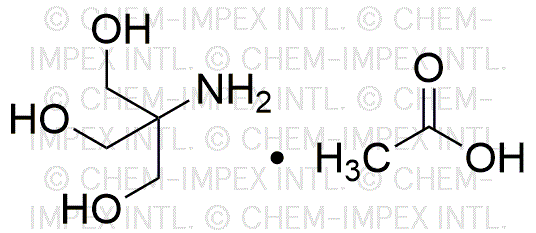Tris(hydroxymethyl)aminomethane acetate is widely utilized in research focused on:
- Biological Buffers: Commonly used in biological and biochemical research to maintain pH levels in various solutions, ensuring optimal conditions for enzyme activity and cellular processes.
- Pharmaceutical Formulations: Acts as a stabilizing agent in drug formulations, enhancing the solubility and bioavailability of active pharmaceutical ingredients.
- Diagnostic Kits: Integral in the development of diagnostic assays, particularly in immunoassays, where precise pH control is crucial for accurate results.
- Cell Culture Media: Employed in cell culture applications to create environments that support cell growth and maintenance, particularly in research involving mammalian cells.
- Cosmetic Products: Utilized in personal care formulations for its buffering capacity, helping to maintain the stability and effectiveness of active ingredients in lotions and creams.
General Information
Properties
Safety and Regulations
Applications
Tris(hydroxymethyl)aminomethane acetate is widely utilized in research focused on:
- Biological Buffers: Commonly used in biological and biochemical research to maintain pH levels in various solutions, ensuring optimal conditions for enzyme activity and cellular processes.
- Pharmaceutical Formulations: Acts as a stabilizing agent in drug formulations, enhancing the solubility and bioavailability of active pharmaceutical ingredients.
- Diagnostic Kits: Integral in the development of diagnostic assays, particularly in immunoassays, where precise pH control is crucial for accurate results.
- Cell Culture Media: Employed in cell culture applications to create environments that support cell growth and maintenance, particularly in research involving mammalian cells.
- Cosmetic Products: Utilized in personal care formulations for its buffering capacity, helping to maintain the stability and effectiveness of active ingredients in lotions and creams.
Documents
Safety Data Sheets (SDS)
The SDS provides comprehensive safety information on handling, storage, and disposal of the product.
Product Specification (PS)
The PS provides a comprehensive breakdown of the product’s properties, including chemical composition, physical state, purity, and storage requirements. It also details acceptable quality ranges and the product's intended applications.
Certificates of Analysis (COA)
Search for Certificates of Analysis (COA) by entering the products Lot Number. Lot and Batch Numbers can be found on a product’s label following the words ‘Lot’ or ‘Batch’.
*Catalog Number
*Lot Number
Certificates Of Origin (COO)
This COO confirms the country where the product was manufactured, and also details the materials and components used in it and whether it is derived from natural, synthetic, or other specific sources. This certificate may be required for customs, trade, and regulatory compliance.
*Catalog Number
*Lot Number
Safety Data Sheets (SDS)
The SDS provides comprehensive safety information on handling, storage, and disposal of the product.
DownloadProduct Specification (PS)
The PS provides a comprehensive breakdown of the product’s properties, including chemical composition, physical state, purity, and storage requirements. It also details acceptable quality ranges and the product's intended applications.
DownloadCertificates of Analysis (COA)
Search for Certificates of Analysis (COA) by entering the products Lot Number. Lot and Batch Numbers can be found on a product’s label following the words ‘Lot’ or ‘Batch’.
*Catalog Number
*Lot Number
Certificates Of Origin (COO)
This COO confirms the country where the product was manufactured, and also details the materials and components used in it and whether it is derived from natural, synthetic, or other specific sources. This certificate may be required for customs, trade, and regulatory compliance.

